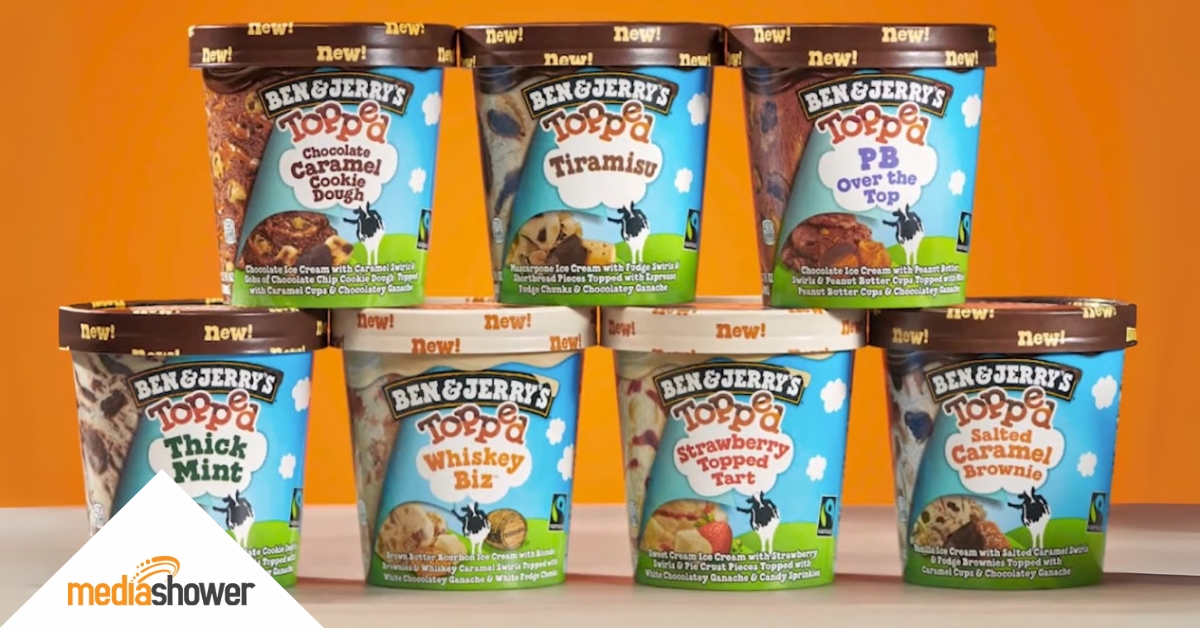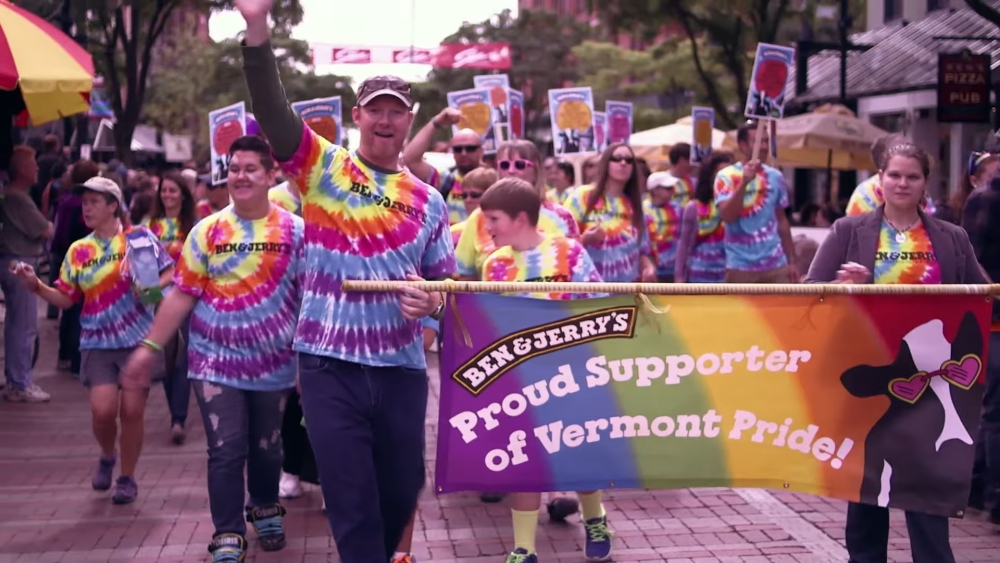
Jerry Greenfield, co-founder of Ben & Jerry’s, just stepped down after 47 years—saying the brand’s independence had been “silenced” under its parent company Unilever.
His exit raises a bigger question: what happens when a values-led brand loses the people who embodied its mission?
For marketers, Ben & Jerry’s legacy is clear: they turned ice cream into activism and built campaigns that became cultural moments. Here’s a look at their boldest stunts—and the lessons they hold for building brands that truly stand for something.
Peace, Love, and Ice Cream
The Campaigns That Set the Standard
Ben & Jerry’s established its identity by turning campaigns into conversations that mattered. Each one sparked reactions—from applause to outrage—that proved people were paying attention. They’re still the gold standard for cause-based marketing.
“What’s the Doughboy Afraid Of?” (1984)
When Pillsbury (the makers of Häagen Dazs) reportedly pressured distributors to block Ben & Jerry’s from market shelves, the company went public. They printed, “What’s the Doughboy afraid of?” on pints, ran ads, and asked customers to get involved.
Fans rallied. Some called Pillsbury’s corporate offices, others wore the bumper stickers like a badge of honor. National media picked up the story, amplifying the underdog narrative. The pressure eventually forced Pillsbury to back down.
Customer reaction: People loved rooting for the little guy. Ben & Jerry’s was fighting for survival, and customers were eager to join the fight.
“One Sweet Whirled” (2002)
Ben & Jerry’s collaborated with the Dave Matthews Band for One Sweet Whirled, the world’s first national global warming campaign. The tagline: “Eat this ice cream and lose 2,000 pounds…of CO2.”
The campaign raised over $300,000 in donations to environmental groups and put a spotlight on global warming, which many Americans had not even heard of at the time.
Responding to popular demand, the brand revived the flavor in 2018 with the name One Sweet World.
“Yes, Pecan!” (2009)
The company renamed its butter pecan flavor to Yes, Pecan! in its scoop shops for the month of Barack Obama’s first inauguration. They donated proceeds to the Common Cause Education Fund, a nonpartisan nonprofit that encourages citizen participation in democracy.
A Good.is article described “Yes, Pecan!” as “amber waves of buttery ice cream with roasted non-partisan pecans.”
“Pecan Resist” (2018)
This flavor launched as an open protest against Trump-era policies, with proceeds going to grassroots organizations. The packaging, created by artist Favianna Rodriguez, became a piece of political art in its own right.
The campaign quickly drew national coverage, with progressives praising the stand and critics calling for boycotts.
Customer reaction: Fans snapped up pints, posting photos online as a way to signal their own resistance. At the same time, conservative commentators slammed the company, which only fueled more attention.
Love it or hate it, the campaign drove conversation—and sales.
“Justice ReMix’d” (2019)
In partnership with the Advancement Project, Ben & Jerry’s launched a campaign for criminal justice reform. Ice cream trucks became rolling billboards, showing up in communities, serving scoops, and sparking conversations.
Customer reaction: For some, the trucks felt like a bridge bringing attention to a serious issue in a way that felt accessible and human. For others, it was confusing to see dessert tied to systemic reform.
That tension created debate, which was exactly the point.

A 2021 announcement on the Ben & Jerry’s website
“Silence = Acceptance” (2023)
This Pride campaign used melting ice cream as a stark visual metaphor for the rollback of LGBTQ+ protections. The message was urgent: Allyship means action. Customers shared the images widely across social media, amplifying the campaign far beyond its paid reach.
Customer reaction: LGBTQ+ advocates praised the clarity and tone, noting it avoided the rainbow-washing so common in June. Critics questioned whether a corporation should weigh in on politics.
The divide showed that the campaign landed where it aimed: It asked people to choose a side.

Source: Peace, Love, and Ice Cream; see video above.
How the Founders Shaped the Brand
Part of what made Ben & Jerry’s campaigns so powerful was the presence of the founders themselves. They were two friends with scruffy hair and worn flannels who believed a brand should reflect human values.
Their image was inseparable from the brand and far removed from the typical corporate executive.
They were approachable, quirky, and willing to speak up.
That human connection gave credibility to every campaign. When the company protested, it felt authentic because the people behind it were visibly invested. The founders were much more than figureheads.
They lived the mission.
Why Jerry Left
When Unilever acquired Ben & Jerry’s in 2000, the agreement included a rare provision: An independent board would oversee the company’s social mission. This gave the brand freedom to act on issues many corporations avoid, from racial justice to climate change.
For decades, that system worked. The company rolled out flavors tied to the causes above, issued statements on current events, and treated campaigns as advocacy as much as advertising.
Greenfield now says that independence has broken down. He pointed to several developments:
- The dismissal of CEO Dave Stever, a 35-year company veteran who helped uphold the brand’s activist culture.
- The restructuring of Unilever’s ice cream brands into a new global entity, The Magnum Company, which consolidated decision-making.
- Increased pressure to reduce social and political engagement.
In Greenfield’s view, those moves undercut the original agreement and weakened the mission that defined Ben & Jerry’s from the beginning.
What’s at Risk
Ben & Jerry’s grew because it offered more than clever flavors. Each pint carried a position, whether on voting rights, LGBTQ+ equality, or climate action. That steady alignment between product and principle built trust with customers who wanted their dollars to reflect their values.
With the 2020 acquisition, the weight shifted to corporate leadership. For any mission-led brand, the test is the same: Values inspire loyalty only when they are practiced consistently and credibly.
When they bought Cherry Garcia and Phish Food, consumers also bought the belief that this company stood for more than sales. With Greenfield’s decision to move on, consumers are watching.
Will Ben & Jerry’s keep living its values in its decisions, or let them fade into empty words?
Marketer Takeaways
Here’s what Ben & Jerry’s has taught us about marketing that takes a stand.
- Write values into the structure. Build systems that keep your mission alive when leadership changes.
- Make campaigns do more than talk. Advocacy sticks when it delivers outcomes.
- Clarity beats neutrality. You can’t appeal to everyone. Make a choice, and that choice will build loyalty.
- Harness founder credibility. When founders or leaders are trusted, their visibility amplifies the brand’s message.
- Design for participation. Invite customers to join in. Involvement turns campaigns into movements.
- Connect product and purpose. Flavors like “Yes Pecan!” or “One Sweet Whirled” showed how even the product itself can carry the cause. That integration makes marketing memorable.
Media Shower’s AI marketing platform helps brands create a signature flavor. Click here for a free trial.



